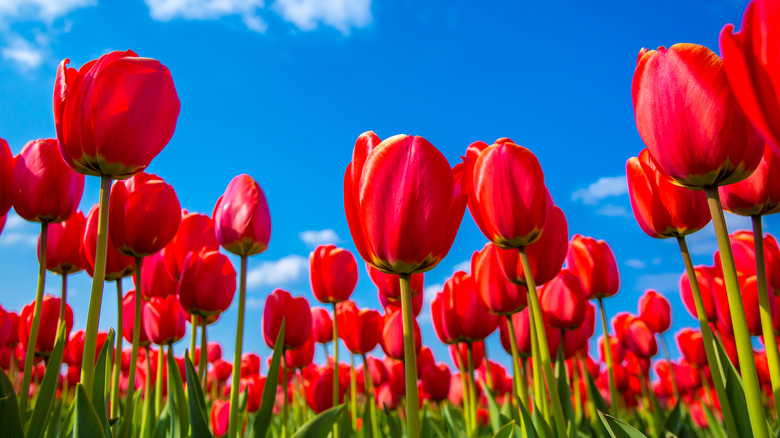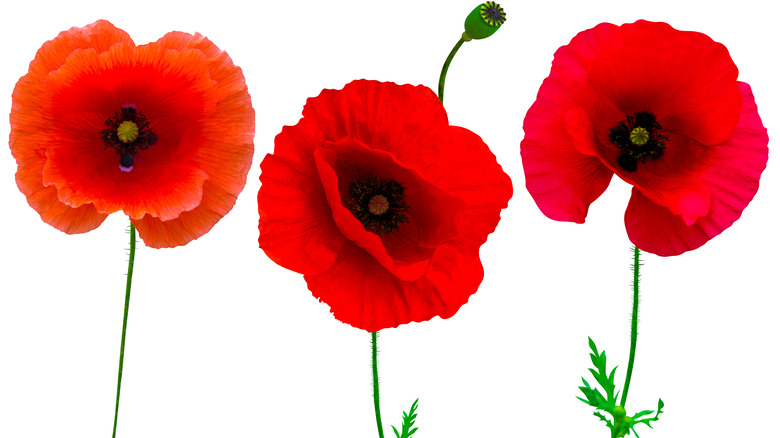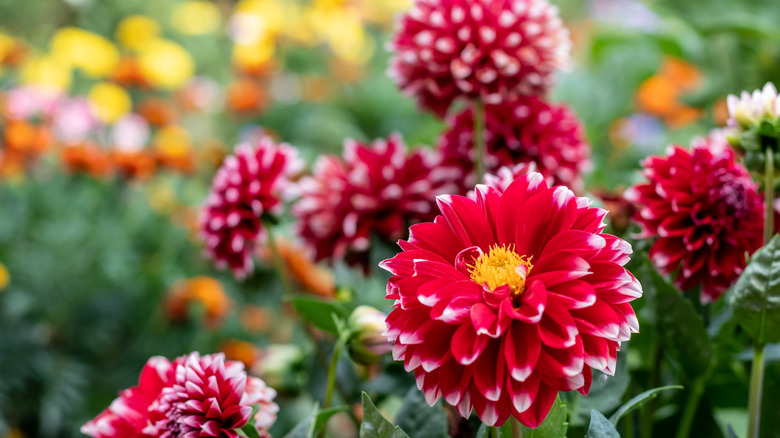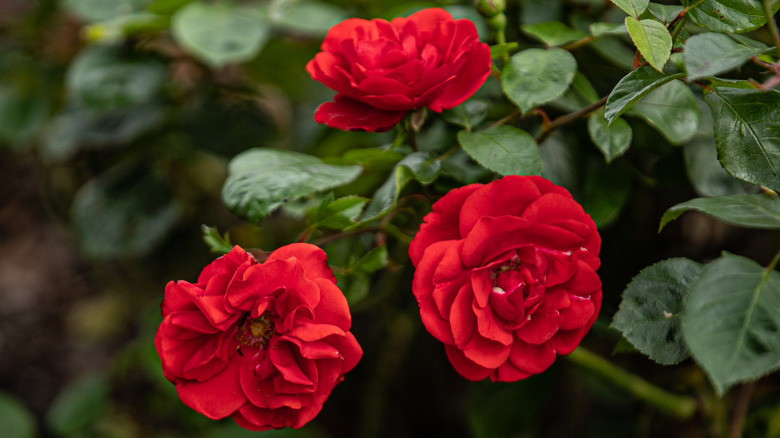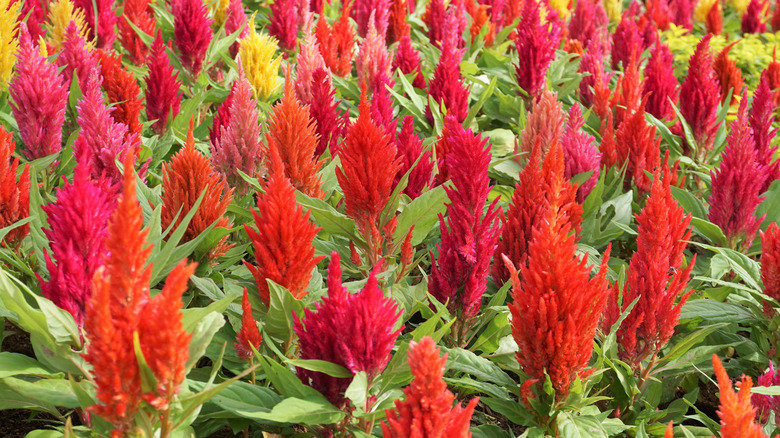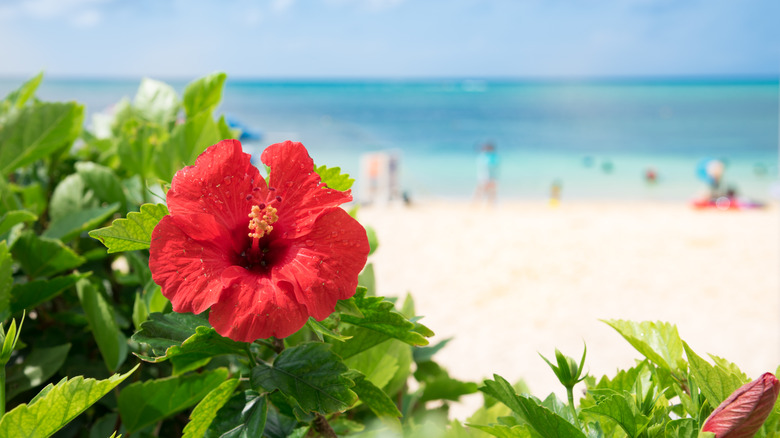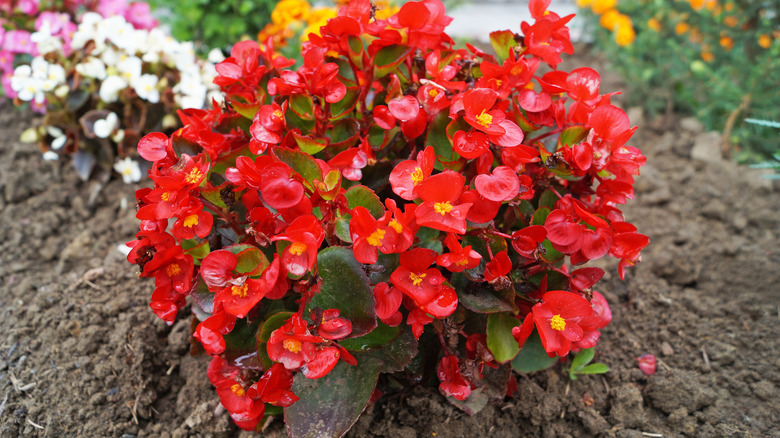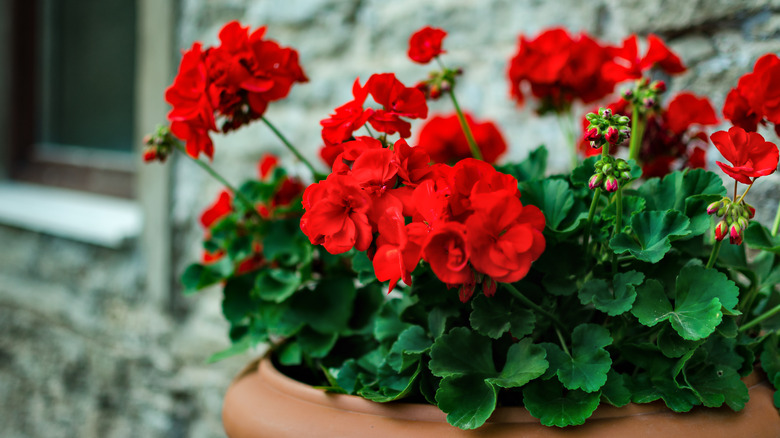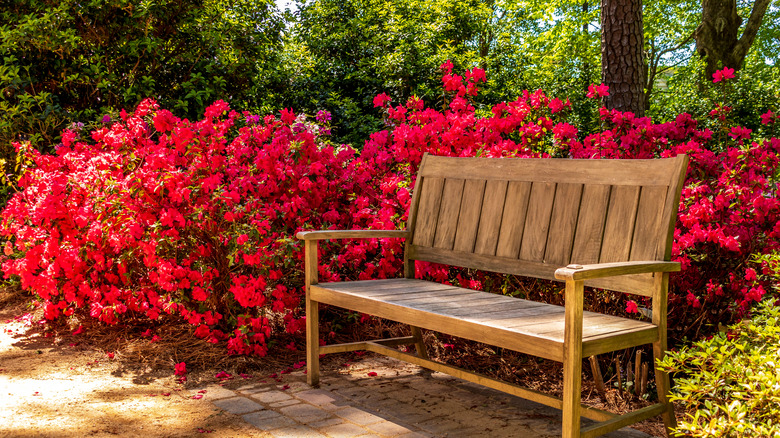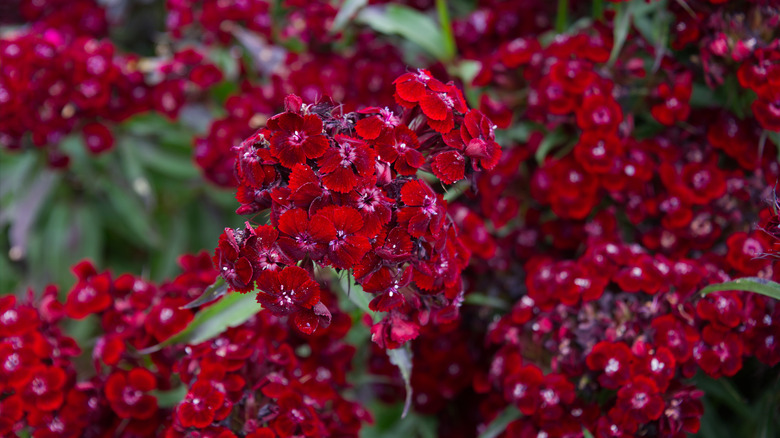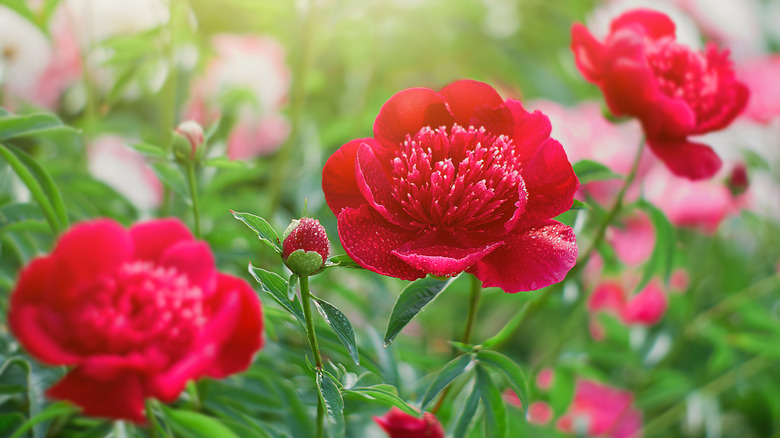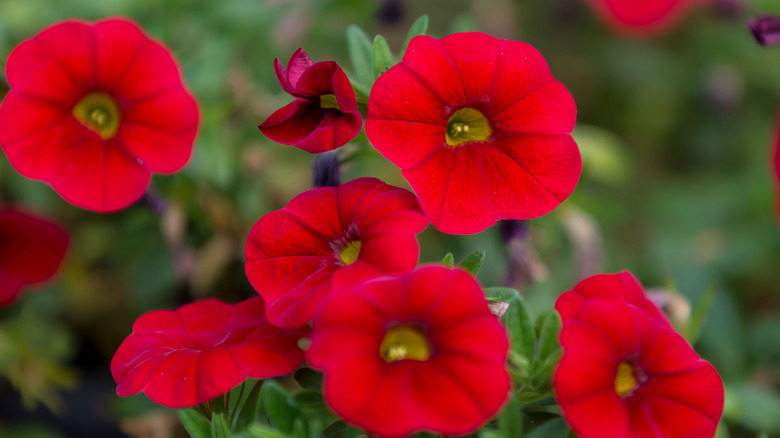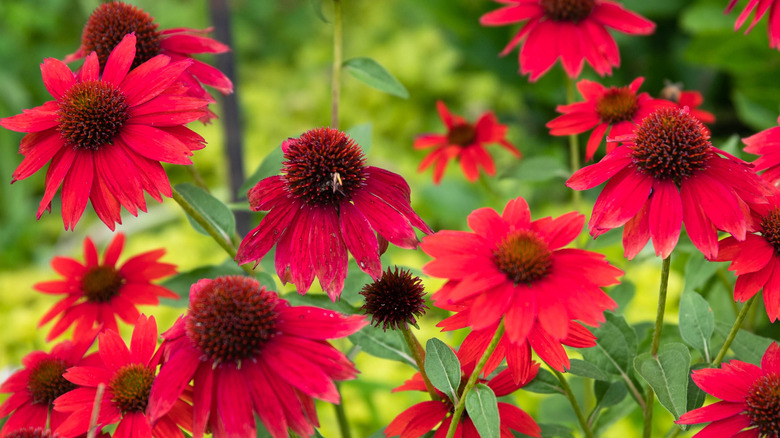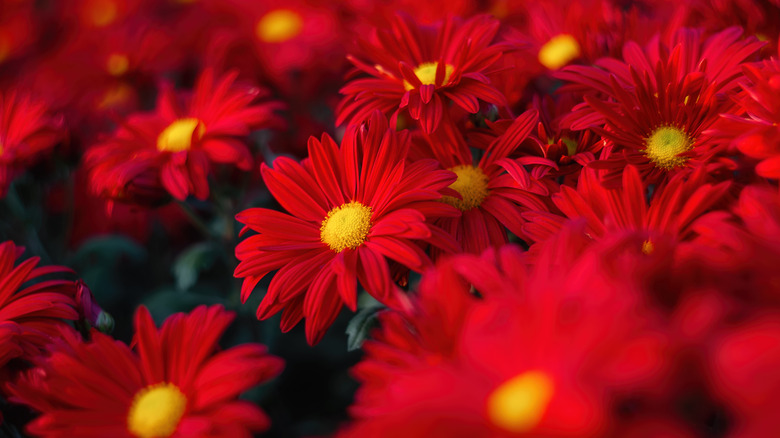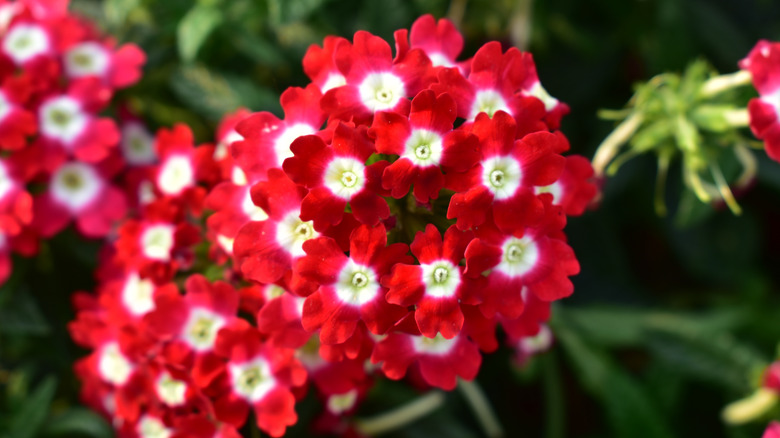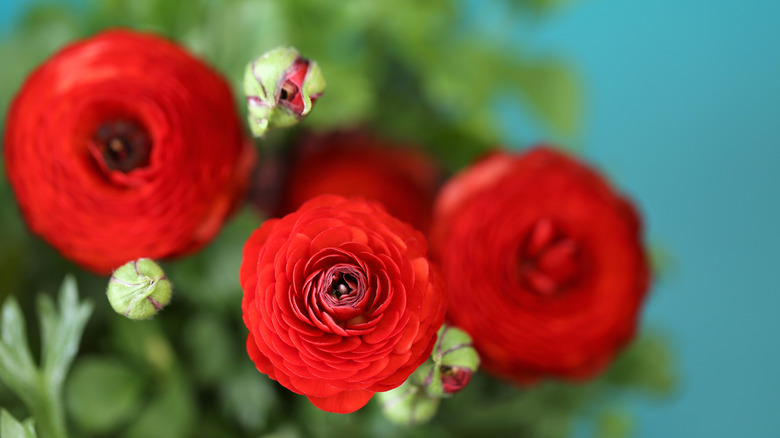15 Types Of Red Flowers That Will Look Perfect In Your Flower Garden
We may receive a commission on purchases made from links.
Whether this is your first season planning a garden or you're an experienced gardener who wants to add some bold accents to your flower bed, you can't go wrong with red. It's widely regarded as the color of passion, and pops vibrantly against the greenery in a garden. You can find glorious crimson hues in bulbs, annuals, and perennials, as noted by Pro Flowers.
We've rounded up 15 types of red flowers that will look perfect in your garden. Even if you don't have a garden and instead use planters on your apartment balcony, these gorgeous flowers will work in just about any setting. Because red demands a lot of attention, you can always start with it in small doses to see how it pairs with other colors that are already present in your flower bed, or choose one area to design a dramatic focal point.
1. Poppy
The poppy (scientific name papaver) comes in many different colors, but it is most widely recognized — and most popular — in its red hue. Historically, they're known as the flower of remembrance, because they're said to pop up on battlefields after the fight has ended. Both real and artificial versions are often given out during memorial services.
If you want to plant them in your garden, Gardening Know How says they're easy to grow. You can start them from seeds, divide an existing plant, or buy them from your local garden center. Just make sure not to overwater them, as they like well-drained soil. Pro Flowers warns that beginner gardeners often kill them by overwatering. USDA Zones 2 through 8 are good candidates for poppies, as long as you ensure they're planted in full sun. Because there are hundreds of varieties of poppy (via Gardening Know How), the bloom time will vary based on the variety you choose.
2. Dahlia
If you want to bring enormous blooms and a dramatic flair to your garden, choose the dahlia (scientific name dahlia). Their flowers can grow to be an entire foot across — a size that earned them the nickname "dinner plate dahlias," according to Longfield Gardens.
Gardening Know How explains that success with your dahlias begins by selecting healthy tubers; this means the outside should be firm to the touch and free of mold or soft spots. Wait to plant them until any chance of frost has passed, and choose an area that gets plenty of full sun. Dahlias do well in moist, well-draining soil.
If your goal is giant blooms, set up support stakes at the time of planting to support them. Additionally, using more fertilizer should help your blooms increase in size. Just look up the details for your particular variety to know how much to use. Dahlias should thrive in USDA zones 8 through 10 (via Pro Flowers).
3. Rose
One hardly needs to introduce the rose (scientific name rosa) since it's arguably one of the most popular flowers in the world. If you want to try growing roses, all the complicated explanations can be overwhelming.
Gardening Know How says that rose bushes need at least six hours of sun per day, in soil that is moist but well-draining. Additionally, roses can be bought in a couple of ways. The first is "bare root," which means they're packaged without soil and their roots are wrapped in plastic (via Gardening Know How). The other is potted and ready to move into the ground without additional prep work. Both varieties should be planted in the spring.
Roses need consistent watering to thrive. During their growing season, Gardening Know How suggests at least an inch of water weekly. Water directly at the roots to protect the roses from debilitating fungal diseases. They can be planted in USDA zones 3 through 11.
4. Plume Celosia
While there are several different varieties of celosia, plume celosia (scientific name celosia plumosa) comes in a fiery color palette of red, yellow, orange, and pink. It's a whimsical, easy-to-grow annual that adds interest to any flower bed or planter. If you're looking for a colorful flower that's low maintenance and blooms throughout the whole summer, you can't go wrong with red celosia.
My Garden Life suggests planting in full sun, as these flowers can handle scorching heat like a champ. As mentioned, because they're low maintenance, you just need to watch out for overwatering. Red celosia are susceptible to root rot if you give them too much H2O, so keep the soil moist, but only just so. If the leaves begin to turn yellow or the plant loses its upright appearance and begins to wilt, these are telltale signs of overwatering. Celosia can be planted in USDA zones 2 through 11.
5. Hibiscus
Want to bring a tropical feel to your garden? Hibiscus (scientific name hibiscus rosa-sinensis) should be tops on your list. There are two types: hardy and tropical. Depending on your gardening desires and zone, you should carefully research before deciding which type of hibiscus is right for you.
For a tropical hibiscus, plant it in a container so you can bring it inside over the winter or else it won't survive. However, hardy hibiscus can survive in the ground through the winter, says Gardening Know How. Just trim it down to a height of around five inches before the winter, and you should see it coming back at the beginning of the following summer.
All varieties of hibiscus need lots of sunlight and consistently moist, well-draining soil. You never want the soil to get dry. Gardening Know How also suggests using an all-purpose fertilizer to maximize blooms and strong growth. Hibiscus can be planted in USDA zones 5 through 8.
6. Begonia
Although there are many varieties of begonia (scientific name begonia), the most recognized are wax begonias and tuberous begonias. Both are annuals and both are excellent performers in pots, window boxes, and hanging baskets. These low maintenance flowers bloom all summer long, plus they self-clean, so no deadheading is required.
While the sun and watering needs vary amongst begonia varieties, HGTV says that many begonias prefer shade or partial sun. Check the care tag of the specific variety you choose to be sure of the light requirements.
HGTV also recommends keeping the soil consistently moist for begonias, but you don't need to saturate it with every watering. If your begonias are going in the ground, surround them with a couple inches of mulch so they can better retain moisture. Both wax and tuberous begonias can be planted in USDA zones 9 through 11.
7. Geranium
Enjoyed for their bright colors, pleasant scent, and low maintenance care, geraniums (scientific name pelargonium) are a classic choice among gardeners. When grown outside, they're annuals, but you can overwinter them inside. They're also a popular choice for growing inside year round, as a companion to other houseplants.
Gardening Know How says you should make sure your geraniums get at least six hours of sunlight, and don't plant them until any chance of frost has passed, as they don't fare well in cold temperatures. For watering, you'll want to keep the soil consistently moist. If you're planting geraniums in pots, they may require daily watering on hotter days. To encourage continuous blooms, deadhead spent blooms as needed. Geraniums can be planted in USDA zones 9 through 12.
8. Azalea
A perennial shrub bursting with beautiful, long-lasting blooms, azaleas (scientific name rhododendron) are a popular choice for any garden or landscape that needs a boost of color.
Most azaleas prefer partial shade and can be scorched by full sun. However, some varieties do well in direct sunlight. When it comes to size, check the care card for your particular plant to ensure you account for enough space. According to Pennington Seeds, some varieties can grow to a whopping height of 20 feet, though dwarf varieties (reaching heights of only a few feet) are more common.
Azaleas need acidic soil in order to bloom proficiently. If you're not sure about your soil's acidity, you can perform a simple soil test and then amend the pH as needed. Because azaleas have shallow root systems, this means the soil needs to be moist and well-draining. Azaleas can be planted in USDA zones 4 through 9.
9. Dianthus
While most varieties are perennial, some types of dianthus (scientific name dianthus) can be annuals or biennials. They bloom in shades of pink, red, and white. Whether you want one that mounds, trails, or grows tall, Garden Design promises that there's a perfect dianthus to fit your garden.
Choose a location that receives a minimum of partial sun, but full sunlight is preferable to guarantee the best blooms. Additionally, dianthus doesn't fare well in shady areas, according to Garden Design. Also, make sure the soil is moist and well-draining. Certain varieties of dianthus prefer more acidic soil, so check the care tag of the variety to choose in case the soil needs to be amended.
Garden Design encourages deadheading your dianthus. If your plant is a few years old and a dead spot forms in the middle, that's a telltale sign it's time to divide it. Dianthus can be planted in USDA zones 3 through 10.
10. Peony
Even people with very little flower knowledge are likely to recognize the layered, prolific blooms of the peony (scientific name paeonia). Though the perennial bush has a short bloom time of just a couple of weeks, their longevity is unparalleled. According to Gardener's Supply Company they can live over 100 years if planted correctly.
Plant your peonies where they'll receive full sunlight. It's important not to crowd them too close together, as they need proper air circulation to prevent a fungal disease called botrytis, says Gardener's Supply Company. Once your peony is established, you don't need to worry about a strict watering schedule — just make sure the soil drains well.
Because peony blooms are so large, it's important to provide support for them. Set up stakes or cages early in the spring to minimize damage to the plant. Peonies can be planted in USDA zones 3 through 9.
11. Petunia
Petunias (scientific name petunia) are lovable annuals. They're easy to grow, come in an incredible array of colors and patterns — even stripes and polka dots — so you can choose a variety that perfectly suits your aesthetic. They can trail, mound, or be compact in shape. Petunias give you prolific flowers throughout the entire season, though most varieties do require some deadheading in order to maximize the never-ending blooms and keep the plant looking healthy.
Garden Design says that you should plant petunias in full sun, even if you're putting them in containers. They have a shallow root system, so regular watering is a must. If there's a particularly hot and dry stretch, the petunias will need daily watering. Leaves turning yellow? That's a sign you're watering a little too much, so ease up on the quantity of water. Petunias can be planted in all USDA zones as annuals.
12. Coneflower
The perennial coneflower (scientific name echinacea) is beloved by pollinators. It's easy to grow, low-maintenance, and has been used in herbal medicinal remedies for hundreds of years. While coneflower is commonly seen in shades of pink or purple, you can find it in a striking shade of red that will look perfect in your garden.
The Old Farmer's Almanac says that coneflowers can grow up to four feet in height, so plan for this vertical growth accordingly. Once they're established, they'll self-sow, which means you'll have effortless blooms to enjoy for years to come.
Choose a location with full sunlight and well-draining soil for coneflower. They're drought-resistant, but Garden Design suggests watering about an inch weekly. If your flowers are on the small side, you can add a bit of compost to the soil and around the plant for additional nourishment. Coneflowers can be planted in USDA zones 3 through 9.
13. Chrysanthemum
More commonly known by the shortened "mums," chrysanthemums (scientific name chrysanthemum) signal the arrival of autumn, come in tons of varieties, and bloom from late summer into the fall. They can be annuals or perennials, though a hardy variety must be chosen to withstand the winter.
Mums are low-maintenance as long as their basic needs are met, says Garden Design. This means they want full sun, nutrient-rich soil, proper air circulation (so don't overcrowd them), and good drainage. One final piece of essential care for mums is "pinching." Gardening Know How explains that this practice translates to more blooms. You pinch back the mums (yes, just pinch with your fingers) when new growth is around six inches, and make sure to remove the stem that's above the second set of leaves. Mums can be planted in USDA zones 5 through 9.
14. Verbena
If you think the hot, dry weather in your area means you can't have beautiful flowers in the garden, let's introduce you to verbena (scientific name verbena.) It's highly tolerant of heat and drought, and comes in annual and perennial varieties. Verbena also thrives in hanging baskets, containers, or the garden bed.
Gardening Know How calls verbena a "tough specimen," and says it needs to be placed somewhere that gets at least eight hours of sun per day. It's not a fussy flower and doesn't mind poor soil quality, but you want to make sure the soil still drains well. Verbena roots do not like being soggy; even though it can go a while without water, Gardening Know How says a weekly watering of an inch will give you better blooms. Verbena can be planted in USDA zones 9 through 11.
15. Ranunculus
With layers of ultra-thin petals, ranunculus (scientific name ranunculus) flowers are a favorite choice for cut flowers and are often used in wedding bouquets. The perennials come in a rainbow of colors, with their deep red shade being especially appealing.
According to Breck's Seeds, ranunculus are grown from corms. They should be planted in the fall for most zones, but you can plant them in early spring if your area is prone to severe winters. Corms require a bit of prep work, and you'll want to read through the steps carefully to ensure they thrive once they're planted.
Breck's Seeds says ranunculus need lots of sun and rich, well-draining soil. Place the "claw" part of the corms down as you plant them, and give a good watering once they're in the ground. Apply a layer of mulch to ensure they retain moisture during this early growth period. Ranunculus can be planted in USDA zones 3 through 10.
